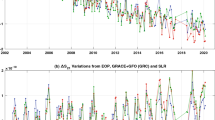Abstract
It is beyond doubt that calibration and validation are essential tools in the process of reaching the goals of gravity missions like GRACE and GOCE and to obtain results of the highest possible quality. Both tools, although general and obvious instruments for any mission, have specific features for gravity missions. Therefore, it is necessary to define exactly what is expected (and what cannot be expected) from calibration and what from validation and how these tools should work in our case. The general calibration and validation schemes for GRACE and GOCE are outlined. Calibration will be linked directly to the instrument and the measurements whereas validation will be linked to data derived from the original measurements. Calibration includes on-ground, internal, and external calibration as well as error assessment. The calibration phase results in corrected measurements along with an a posteriori error model. Validation of e.g. calibrated measurements or geoid heights means checking against independent data to assess whether there are no systematic errors left and/or whether the error model describes the true error reasonably well. Geodetic methods for calibration typically refer to external calibration and error assessment, and will be illustrated with an example.
Similar content being viewed by others
References
Cesare, S.: 2002, ‘Performance requirements and budgets for the gradiometric mission’. Issue 1 GO-TN-AI-0027, Preliminary Design Review, Alenia.
ESA: 1999, 'Gravity Field and Steady-State Ocean Circulation Mission’. Reports for mission selection; the four candidate earth explorer core missions. ESA SP-1233(1).
Koop, R., P. Visser, and C. Tscherning: 2001, ‘Aspects of GOCE calibration’. In: International GOCE user workshop, Vol. WPP-188.
Lemoine, F., S. Kenyon, J. Factor, R. Trimmer, N. Pavlis, D. Chinn, C. Cox, S. Klosko, S. Luthcke, M. Torrence, Y. Wang, R. Williamson, E. Pavlis, R. Rapp, and T. Olson: 1998, ‘The development of the joint NASA GSFC and the National Imagery and Mapping Agency (NIMA) geopotential model EGM96’. TP 1998-206861, NASA Goddard Space Flight Center.
Rapp, R., Y. Wang, and N. Pavlis: 1991, ‘The Ohio State 1991 geopotential and sea surface topography harmonic coefficient models’. Report No. 410, OSU.
SID: 2000, ‘GOCE End-to-End Performance Analysis’. Final Report ESTEC Contract No. 12735/98/NL/GD, SID.
Tapley, B. and C. Reigber: 1999, ‘GRACE: a satellite-to-satellite tracking geopotential mapping mission’. In: I. Marson and H. Sünkel (eds.): Bolletino di Geofisica Teorica ed Applicata, Sep.-Dec. 1999, Proceedings of the 2nd Joint Meeting of the International Gravity and the International Geoid Commission, Trieste 7-12 Sept. 1998, ISSN 0006-6729, Vol. 40. p. 291.
Velicogna, I., J. Wahr, C. Milly, M. Shaltout, and A. ArRajehi: 2000, ‘Validation of GRACE Satellite Geoid Measurements’. Poster presented at AGU Fall Meeting, San Francisco.
Willemenot, E.: 1999, ‘Capacitive gradiometer: Calibration and verification approach’. Concluding Technical Report RTS 19/3825 DMPH/Y, Onera.
Author information
Authors and Affiliations
Rights and permissions
About this article
Cite this article
Bouman, J., Koop, R. Geodetic Methods for Calibration of GRACE and GOCE. Space Science Reviews 108, 293–303 (2003). https://doi.org/10.1023/A:1026127409015
Issue Date:
DOI: https://doi.org/10.1023/A:1026127409015




